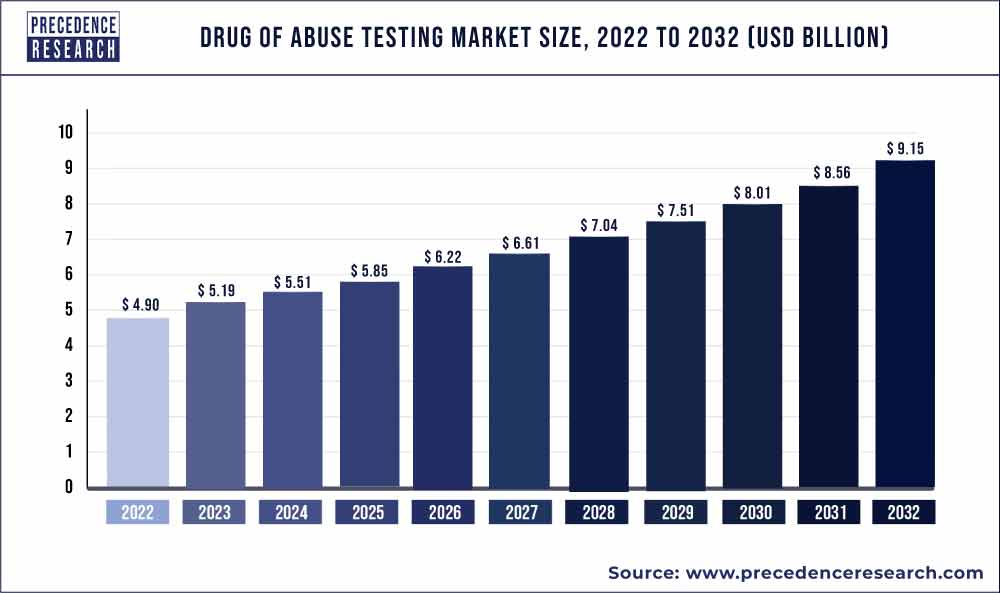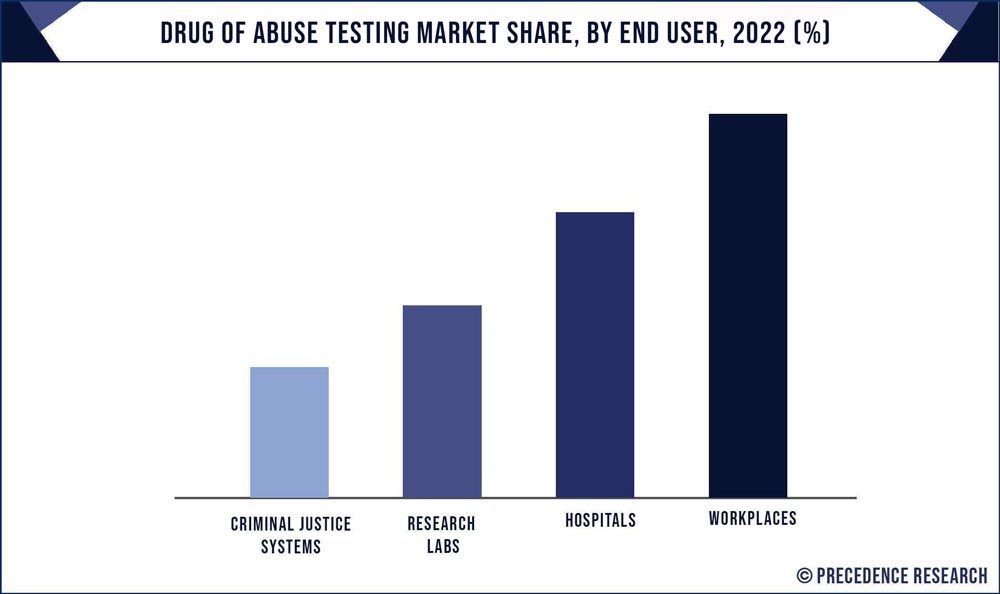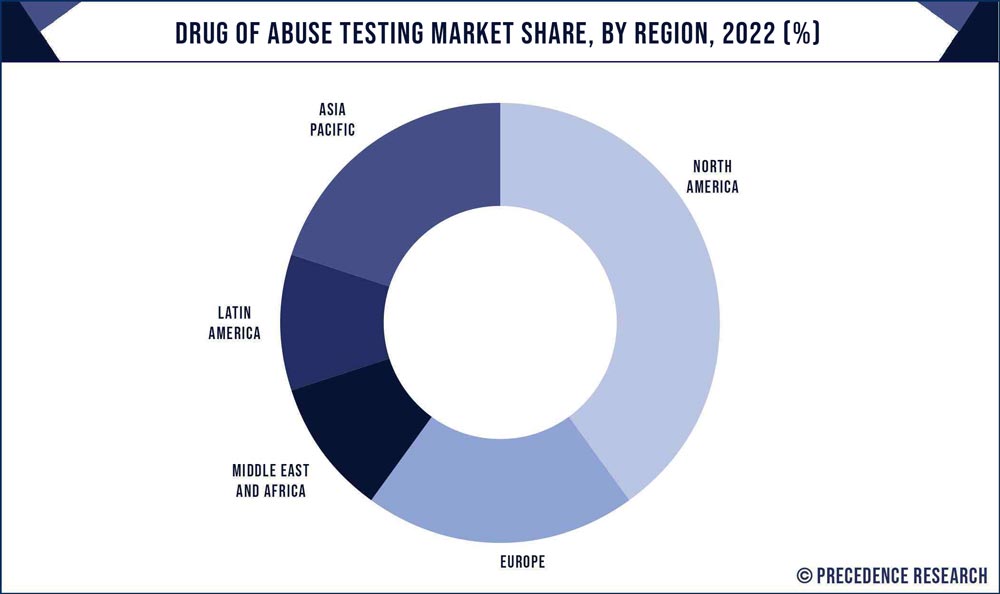June 2025
Drug of Abuse Testing Market (By Drug Type: Alcohol, Cocaine, Marijuana/Cannabis, LSD, Opioids, and Others; By Sample Type: Urine, Saliva, Blood, and others; By End User: Workplaces, Criminal Justice Systems, Hospitals, and Research Labs) - Global Industry Analysis, Size, Share, Growth, Trends, Regional Outlook, and Forecast 2023 - 2032
The global drug of abuse testing market size was estimated at US$ 4.90 billion in 2022 and is expected to hit US$ 9.15 billion by 2032, poised to grow at a noteworthy compound annual growth rate (CAGR) of 6.5% from 2023 to 2032.

The drug of abuse testing market is primarily driven by the factors such as strict laws that mandates the drug abuse testing, growing government initiatives regarding drug abuse, increased consumption of alcohol and other drugs, and increasing mortality due to drugs. Moreover, an increase in the number of clinics and research labs have been witnessed in the past few years that provides drug of abuse testing services. The development of cost effective testing kits and technological advancements in this field has promoted the growth of the market across the globe.
The production and consumption of drugs is growing across the world. According to the United Nations Office on Drugs and Crime, around 246 million people used illicit drug and the population aged between 15 and 64 years, in 2013. A rise of 3 million people was recorded as compared to the previous year. Further, in 2013, around 27 million people were suffering from drug use disorder. Around 24% to 36% of the heroin consuming population passes through correctional system annually in US. Moreover, studies have found that there is a growing prevalence of HIV amongst the people who continues to inject drugs. According to UNDOC, around 40% of the global people who inject drugs are infected with HIV. Hence, the rising prevalence of HIV is a major factor that encourages the restriction on drug use, thereby propelling the growth of the global drug of abuse testing market.
| Report Highlights | Details |
| Market Size in 2023 | US$ 5.19 Billion |
| Growth Rate from 2023 to 2032 | CAGR of 6.5% |
| Market Size by 2032 | US$ 9.15 Billion |
| Largest Market | North America |
| Fastest Growing Market | Asia Pacific |
| Base Year | 2022 |
| Forecast Period | 2023 to 2032 |
| Segments Covered | Drug Type, Sample Type, End User, Region |
| Companies Mentioned | Danaher Corporation, Abbott Laboratories, Quest Diagnostics, Inc., LabCorp, Cordant Health Solutions, Legacy Medical Services, Mayo Clinic Laboratories, DrugScan, LGC Group, Precision Diagnostics |
Driver:
The market for drug abuse testing has risen substantially due to drug and substance abuse growing more and more common, particularly within student populations. Peer pressure, stress, and easy access to drugs are some of the factors that have led to rising rates of substance abuse in different parts of the world. For instance, 45.7% of students in a recent study carried out in Nigeria were found to be abusing drugs or other substances. This finding highlights the critical need for drug abuse testing services to detect and treat these alarming problems. Furthermore, legal and occupational requirements have been a major factor in increasing the demand for drug testing services. To ensure the security and well-being of their communities, numerous employers and educational institutions have put in place drug testing policies. For instance, drug testing is required by a few American universities for students participating in extracurricular or sports activities, which increases the demand for drug testing services on campuses.
Furthermore, there is a greater focus on addressing this issue as part of growing awareness of the risks to the public's health that drug abuse poses, including addiction, accidents, and mental health issues. Governments and health authorities are placing a higher priority on the fight against drug abuse, and a key component of this strategy is drug testing. For instance, the US opioid crisis led to a greater focus on drug abuse testing as part of all-encompassing strategies to address opioid addiction and lower the number of overdose deaths. Technological developments in drug testing have improved the accessibility and efficiency of testing, particularly regarding quick and non-invasive procedures. These developments have made it easier to implement drug testing in a range of contexts, including educational institutions, which has contributed to the market for drug abuse testing growth. Programs to raise public awareness and educate the public about the risks associated with drug abuse have additionally highlighted the significance of routine testing to identify and treat substance abuse problems. Educational institutions frequently work with local government agencies and groups to run awareness campaigns, offer support services to students who are struggling with substance abuse, and encourage the use of drug testing as a preventative and intervention strategy.
Restraint:
The belief that drug testing violates people's rights is an important hindrance to the market for drug abuse testing. Some people oppose drug testing and are reluctant to participate in drug abuse treatment programs as they believe that doing so violates their civil rights and invades their privacy. This point of view hinders the market's growth, particularly in countries where strong legal or cultural protections for people's privacy and autonomy are in place. For instance, drug and alcohol testing is permitted in specific circumstances in Canada. Similar bans in other nations prevent drug and alcohol testing from becoming widely used, which limits the market's ability to grow.
Opportunity:
The growing demand for drug testing in emerging markets, especially in the Asia-Pacific and LAMEA regions, offers a significant opportunity in the drug abuse testing market. Due to the rising incidence of drug abuse, a growing understanding of the value of drug testing, and the development of the local healthcare system, these markets present bright opportunities for the growth of the drug abuse testing sector. Furthermore, a major key driver of market growth is expected to be the increase in clinics and research labs providing drug abuse testing services in these regions. Furthermore, there is a rise in demand for drug testing goods and services due to government initiatives to address drug abuse issues in these areas. Major players in the drug abuse testing market are diversifying their product lines and allocating resources to research and development. Drug abuse testing becomes even more necessary as the Asia-Pacific region, with an emphasis on developing nations like China and India, is predicted to be the most promising market over the projection period.
By drug type, the marijuana/cannabis segment led the global drug of abuse testing market with remarkable revenue share in 2022. This is solely attributable to the growth in the production and consumption of marijuana across the globe. As per the data revealed by the Substance abuse & Mental Health Service Administration, in 2018, around 43.5 million people used marijuana.
On the other hand, the opioids segment is gaining traction due to its growing consumption among the population. According to the National Center for Drug Abuse Statistics, around 2 million US people had opioids use disorder in 2018.
By sample type, the urine segment led the global drug of abuse testing market with remarkable revenue share in 2022. Urine analysis is the most common type of sample testing to detect drug of abuse. Moreover it is widely used by the work places and criminal justice systems. Further, the growing number of medical centers and clinical labs is fostering the segment growth. The urine analysis is cheap that further boos the growth of this segment across the globe.
By end user, the workplaces segment led the global drug of abuse testing market with remarkable revenue share in 2022.

The workplaces extensively uses the drug of abuse testing to ensure that the employees are free from any drug addiction and can dedicate their time to work efficiently.
Based on the region, the North America dominated the global drug of abuse testing market in 2022, in terms of revenue and is estimated to sustain its dominance during the forecast period. This is attributed to the extensive use and consumption of drugs in the major market like the US. Further, the presence of numerous key market players in the region and their strategical developments fueled the growth of the drug of abuse market in this region.Around 24% to 36% of the heroin consuming population passes through correctional system annually in US. The increasing rate of substance use disorder in North America is fostering the market growth. Further, the growing government initiative to trace the use of drugs among the population is facilitating the adoption of drug of abuse testing. For instance, the government of US implemented Patients and Communities Act to counter the problem of drug abuse.

On the other hand, Asia Pacific is estimated to be the most opportunistic market during the forecast period. The emerging nations such as India and China is expected to foster the demand for the drug of abuse testing demand in the forthcoming years. The growing consumption of illicit drugs and the growing government initiative to counter the excessive use of drugs among the youth is significantly driving the drug of abuse testing market in this region.
Some of the prominent players:
Market Segmentation
By Drug Type
By Sample Type
By Product
By Application
By End User
By Geography
For inquiries regarding discounts, bulk purchases, or customization requests, please contact us at sales@precedenceresearch.com
No cookie-cutter, only authentic analysis – take the 1st step to become a Precedence Research client
June 2025
January 2025
November 2024
January 2025